七年级英语阅读教学教程文件
- 格式:ppt
- 大小:1.36 MB
- 文档页数:9
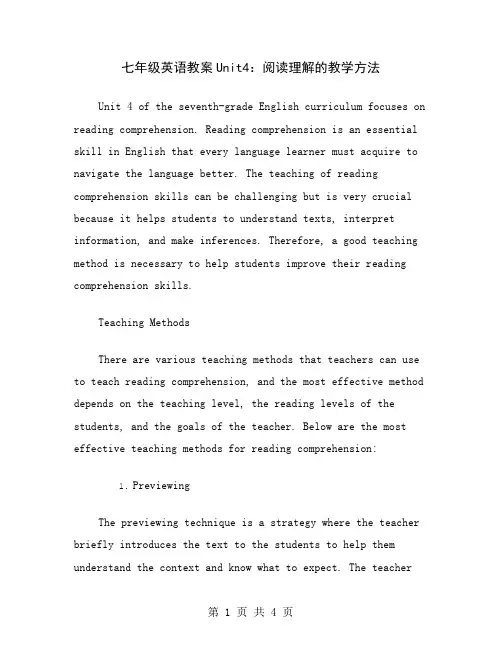
七年级英语教案Unit4:阅读理解的教学方法Unit 4 of the seventh-grade English curriculum focuses on reading comprehension. Reading comprehension is an essential skill in English that every language learner must acquire to navigate the language better. The teaching of reading comprehension skills can be challenging but is very crucial because it helps students to understand texts, interpret information, and make inferences. Therefore, a good teaching method is necessary to help students improve their reading comprehension skills.Teaching MethodsThere are various teaching methods that teachers can use to teach reading comprehension, and the most effective method depends on the teaching level, the reading levels of the students, and the goals of the teacher. Below are the most effective teaching methods for reading comprehension:1.PreviewingThe previewing technique is a strategy where the teacher briefly introduces the text to the students to help them understand the context and know what to expect. The teachercan preview the text by asking students for their prior knowledge of the topic or by providing some background information. Previewing helps students activate their prior knowledge, which increases their comprehension and critical thinking ability.2.SkimmingSkimming is a teaching method where the teacher directs students to read a text quickly, but without paying too much attention to details. Skimming helps students to get the overall meaning of a text, and it also helps in improving speed reading skills.3.ScanningWhen reading comprehension involves finding specific information in the text, scanning is the most effective teaching method. Scanning is where the teacher directs students to look for specific information within a text, such as dates, names, or numbers. Scanning helps students learn how to locate specific information within a text quickly.4.PredictingPredicting is a technique where the teacher predicts what comes next in the text, and the students use this prediction to make assumptions about what they are reading. Predicting helps students to anticipate the content of the text, and it also enhances their critical thinking skills.5.Setting a PurposeSetting a purpose is a teaching method where the teacher sets a purpose for the students to achieve when reading a text. Setting a purpose helps students to focus on the specific information they are looking for, and it also helps students to read the text more critically.6.QuestioningQuestioning is another effective teaching method for reading comprehension. The teacher can ask students questions about the text to help them understand the content better. The questions can involve asking the students to predict what comes next in the text, summarize the text or asking fortheir opinions about the text. Questioning enhances students' comprehension and critical thinking skills.7.Graphic OrganizersGraphic organizers help students to identify and organize information in a structured way. They include mind maps, diagrams, Venn diagrams, and charts. Graphic organizers are effective teaching methods because they help students to process information visually, which enhances their comprehension and critical thinking skills.ConclusionReading comprehension is an essential English language skill that students must learn to achieve fluency in the language. The teaching of reading comprehension skills can be challenging, but the teaching methods discussed above make the process simpler and more effective. Teachers can, therefore, use the various teaching methods to help their students to improve their reading comprehension skills.。
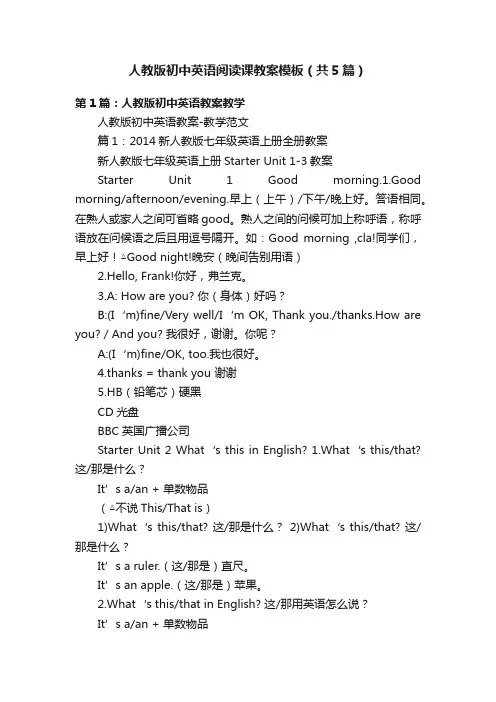
人教版初中英语阅读课教案模板(共5篇)第1篇:人教版初中英语教案教学人教版初中英语教案-教学范文篇1:2014新人教版七年级英语上册全册教案新人教版七年级英语上册Starter Unit 1-3教案Starter Unit 1 Good morning.1.Good morning/afternoon/evening.早上(上午)/下午/晚上好。
答语相同。
在熟人或家人之间可省略good。
熟人之间的问候可加上称呼语,称呼语放在问候语之后且用逗号隔开。
如:Good morning ,cla!同学们,早上好!△Good night!晚安(晚间告别用语)2.Hello, Frank!你好,弗兰克。
3.A: How are you? 你(身体)好吗?B:(I‘m)fine/Very well/I‘m OK, Thank you./thanks.How are you? / And you? 我很好,谢谢。
你呢?A:(I‘m)fine/OK, too.我也很好。
4.thanks = thank you 谢谢5.HB(铅笔芯)硬黑CD光盘BBC英国广播公司Starter Unit 2 What‘s this in English? 1.What‘s this/that? 这/那是什么?It’s a/an + 单数物品(△不说This/That is)1)What‘s this/that? 这/那是什么?2)What‘s this/that? 这/那是什么?It’s a ruler.(这/那是)直尺。
It’s an apple.(这/那是)苹果。
2.What‘s this/that in English? 这/那用英语怎么说?It’s a/an + 单数物品(△不说This/That is)What‘s this in English? 这用英语怎么说?It’s a jacket.夹克衫What‘s that in English? 那用英语怎么说?It’s an orange.橘子。
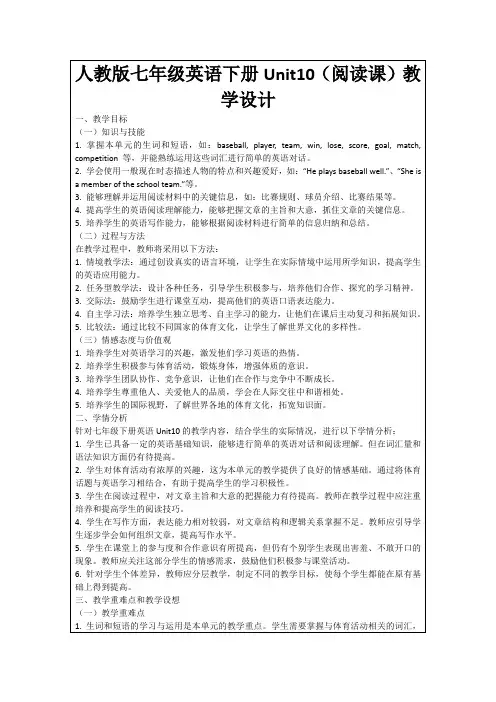
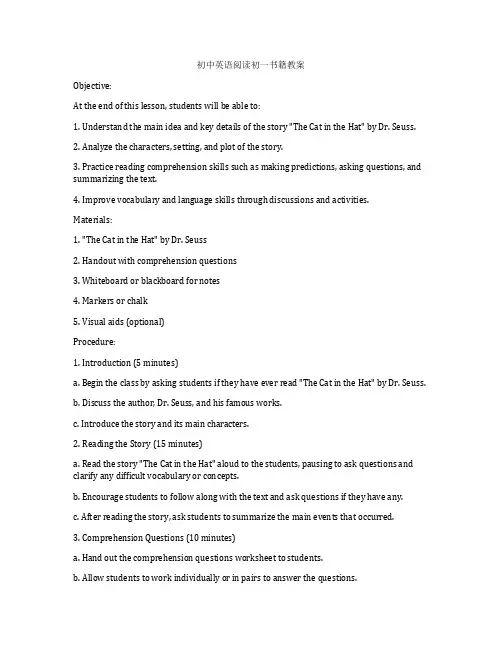
初中英语阅读初一书籍教案Objective:At the end of this lesson, students will be able to:1. Understand the main idea and key details of the story "The Cat in the Hat" by Dr. Seuss.2. Analyze the characters, setting, and plot of the story.3. Practice reading comprehension skills such as making predictions, asking questions, and summarizing the text.4. Improve vocabulary and language skills through discussions and activities. Materials:1. "The Cat in the Hat" by Dr. Seuss2. Handout with comprehension questions3. Whiteboard or blackboard for notes4. Markers or chalk5. Visual aids (optional)Procedure:1. Introduction (5 minutes)a. Begin the class by asking students if they have ever read "The Cat in the Hat" by Dr. Seuss.b. Discuss the author, Dr. Seuss, and his famous works.c. Introduce the story and its main characters.2. Reading the Story (15 minutes)a. Read the story "The Cat in the Hat" aloud to the students, pausing to ask questions and clarify any difficult vocabulary or concepts.b. Encourage students to follow along with the text and ask questions if they have any.c. After reading the story, ask students to summarize the main events that occurred.3. Comprehension Questions (10 minutes)a. Hand out the comprehension questions worksheet to students.b. Allow students to work individually or in pairs to answer the questions.c. Encourage students to use the text to find the answers and to think critically about the story.d. Go over the answers as a class and discuss any difficult questions or interpretations.4. Character Analysis (10 minutes)a. Ask students to identify the main characters in the story and describe their traits and actions.b. Encourage students to think about how the characters' actions contribute to the plot and themes of the story.c. Discuss the character development and how the author portrays the characters' personalities.5. Vocabulary Practice (10 minutes)a. Introduce new vocabulary words from the story and provide definitions.b. Have students practice using the vocabulary words in sentences.c. Encourage students to actively listen and identify the vocabulary words used during the discussion.6. Closure (5 minutes)a. Summarize the main points of the story and discuss any themes or messages that students took away from the story.b. Ask students if they enjoyed the story and why or why not.c. Encourage students to think about what they learned and how they can apply it to their own lives.Extensions:1. Have students create their own story with a similar theme or message using the vocabulary words they learned.2. Assign a written response or essay discussing their thoughts on the story and its themes.3. Encourage students to read other books by Dr. Seuss and discuss their similarities and differences.。
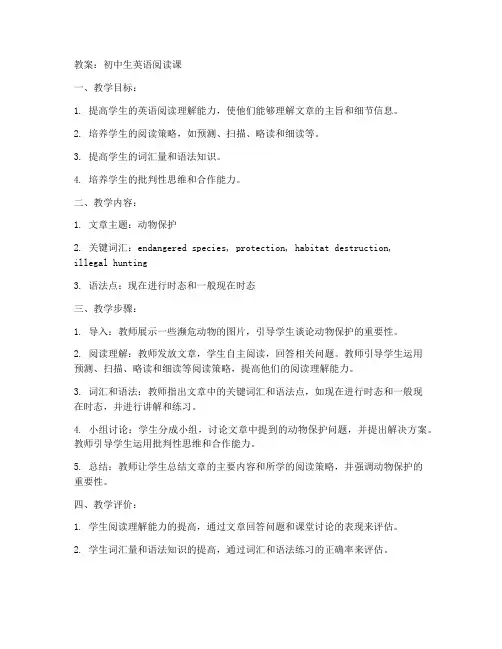
教案:初中生英语阅读课一、教学目标:1. 提高学生的英语阅读理解能力,使他们能够理解文章的主旨和细节信息。
2. 培养学生的阅读策略,如预测、扫描、略读和细读等。
3. 提高学生的词汇量和语法知识。
4. 培养学生的批判性思维和合作能力。
二、教学内容:1. 文章主题:动物保护2. 关键词汇:endangered species, protection, habitat destruction,illegal hunting3. 语法点:现在进行时态和一般现在时态三、教学步骤:1. 导入:教师展示一些濒危动物的图片,引导学生谈论动物保护的重要性。
2. 阅读理解:教师发放文章,学生自主阅读,回答相关问题。
教师引导学生运用预测、扫描、略读和细读等阅读策略,提高他们的阅读理解能力。
3. 词汇和语法:教师指出文章中的关键词汇和语法点,如现在进行时态和一般现在时态,并进行讲解和练习。
4. 小组讨论:学生分成小组,讨论文章中提到的动物保护问题,并提出解决方案。
教师引导学生运用批判性思维和合作能力。
5. 总结:教师让学生总结文章的主要内容和所学的阅读策略,并强调动物保护的重要性。
四、教学评价:1. 学生阅读理解能力的提高,通过文章回答问题和课堂讨论的表现来评估。
2. 学生词汇量和语法知识的提高,通过词汇和语法练习的正确率来评估。
3. 学生批判性思维和合作能力的提高,通过小组讨论的表现和提出的解决方案来评估。
五、教学资源:1. 文章:关于动物保护的英文文章。
2. 图片:濒危动物的图片。
3. 词汇和语法练习:相关的练习题。
六、教学时间:1课时(40分钟)七、教学建议:1. 在课堂上鼓励学生积极参与,提高他们的自信心和兴趣。
2. 针对不同学生的水平,可以适当调整教学内容和难度。
3. 鼓励学生在课后进行自主阅读,扩大词汇量和提高阅读能力。
4. 注重培养学生的批判性思维和合作能力,提高他们的综合素养。
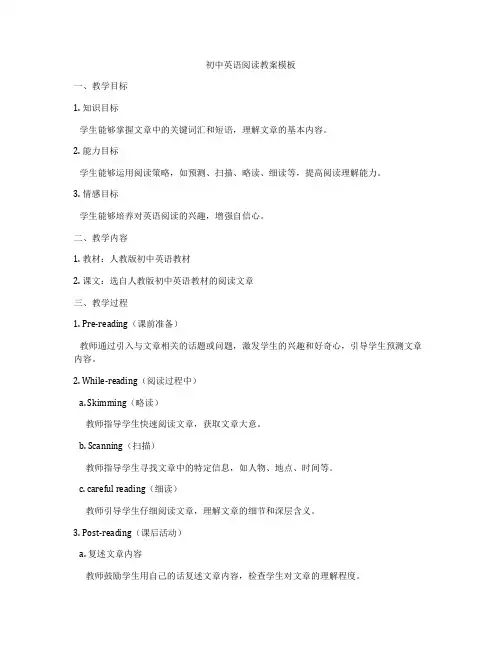
初中英语阅读教案模板一、教学目标1. 知识目标学生能够掌握文章中的关键词汇和短语,理解文章的基本内容。
2. 能力目标学生能够运用阅读策略,如预测、扫描、略读、细读等,提高阅读理解能力。
3. 情感目标学生能够培养对英语阅读的兴趣,增强自信心。
二、教学内容1. 教材:人教版初中英语教材2. 课文:选自人教版初中英语教材的阅读文章三、教学过程1. Pre-reading(课前准备)教师通过引入与文章相关的话题或问题,激发学生的兴趣和好奇心,引导学生预测文章内容。
2. While-reading(阅读过程中)a. Skimming(略读)教师指导学生快速阅读文章,获取文章大意。
b. Scanning(扫描)教师指导学生寻找文章中的特定信息,如人物、地点、时间等。
c. careful reading(细读)教师引导学生仔细阅读文章,理解文章的细节和深层含义。
3. Post-reading(课后活动)a. 复述文章内容教师鼓励学生用自己的话复述文章内容,检查学生对文章的理解程度。
b. 讨论和交流教师引导学生就文章中的话题进行讨论和交流,培养学生的口头表达能力。
四、教学评价1. 课堂参与度观察学生在课堂上的积极参与情况,包括回答问题、参与讨论等。
2. 阅读理解测试通过课后的小测试或作业,评估学生对文章内容的理解程度。
3. 口头表达能力评估学生在讨论和交流中的口头表达能力。
五、教学资源1. 教材:人教版初中英语教材2. 多媒体教学设备:如投影仪、电脑等六、教学时间1课时(40分钟)七、教学建议1. 教师应注重培养学生的阅读兴趣,鼓励学生主动参与课堂活动。
2. 教师应根据学生的实际情况,适当调整教学内容和难度。
3. 教师应注重学生的个体差异,给予每个学生充分的关注和指导。
通过以上教学设计,教师可以有效地进行初中英语阅读教学,提高学生的阅读理解能力和英语综合运用能力。
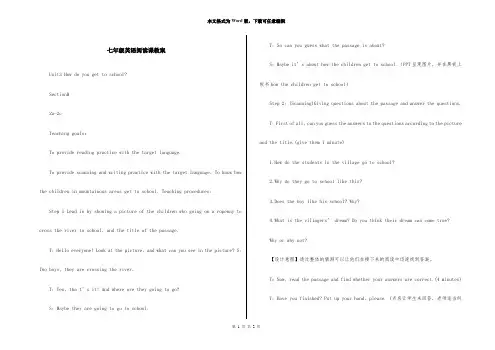
七年级英语阅读课教案Unit3 How do you get to school?SectionB2a-2cTeaching goals:To provide reading practice with the target language.To provide scanning and writing practice with the target language. To know how the children in mountainous areas get to school. Teaching procedures:Step 1 Lead in by showing a picture of the children who going on a ropeway to cross the river to school, and the title of the passage.T: Hello everyone! Look at the picture, and what can you see in the picture? S: Two boys, they are crossing the river.T: Yes, tha t’s it! And where are they going to go?S: Maybe they are going to go to school. T: So can you guess what the passage is about?S: Maybe it’s about how the children get to school.(PPT呈现图片,并在黑板上板书how the children get to school)Step 2: (Scanning)Giving questions about the passage and answer the questions. T: First of all, can you guess the answers to the questions according to the picture and the title.(give them 1 minute)1.How do the students in the village go to school?2.Why do they go to school like this?3.Does the boy like his school? Why?4.What is the villagers’ dream? Do you think their dream can come true?Why or why not?【设计意图】通过整体的猜测可以让他们在接下来的阅读中迅速找到答案。

初一英语阅读理解教案初一英语阅读理解教案众所周知阅读理解的能力,大到我们生活的各个领域,小到我们现实的各种各样的考试。
小编为大家整理的初一英语阅读理解教案,欢迎前来查阅。
初一英语阅读理解教案1(一)、教学材料自选阅读材料《the first transcontinental railroad》,摘自Central Pacific Railroad Photographic History Museum.(二)、教学课型:(45分钟)本课是一节基于互惠式教学理论设计的英语阅读课。
通过互惠式学习的四个步骤:Prediction; Clarification; Questioning; Summary,教师引导学生对文章进行阅读猜测,阅读难点澄清,设计问题最后对文章进行总结,旨在训练学生自主的阅读能力。
(三)、教学理念和总体思路交互式教学是一种学生合作互动式的学习方法,其理论基础是维果茨基的最近发展区理论和社交互动理论。
该教学方法涉及高度的人际互动和合作,学生逐步学会帮助同伴构建文本意义。
过程包括四步:总结、设问、澄清和预测,在这样的一个过程中学生从旁观者转为表演者。
这种学习中的互动可发生在生生之间,也可发生在师生之间。
例如总结这个环节可以帮助学生将文本中最重要的信息,主题和观点识别、释义、集合、整理成为更清晰和简洁的表达。
而澄清这一步可以让学生对于不清楚的难点疑点做一弥补和加强。
(四)、教学内容分析本篇阅读材料摘自一篇讲话稿,是对中国劳工对于美国大陆铁路建设的贡献的肯定和赞扬。
结构上看,有一条比较清晰的时间轴,按照缘由、过程和结果的顺序。
从文体上来说,这篇演讲稿中记叙描写的部分很多。
内容上看,文章涉及到历史背景,文化背景,学习这篇文章,需要学生提前对历史文化有所了解,才能更深刻地理解文章的意义。
根据阅读材料的特点设计了有针对性的问题和活动,一步步引导学生的阅读。
(五)、教学目标(1)知识和能力目标a. 让学生认识了解美国第一条跨大陆铁路的历史及其重要意义;b. 让学生学习并了解中国劳工的贡献;c. 培养学生的批判性思维能力和人文素养;(2)过程与方法目标a. 通过历史背景介绍引入话题;b. 通过预测,知识点讲解,小组讨论,总结复习四步进行让学生完成阅读任务,掌握内容,升华知识点和意识。
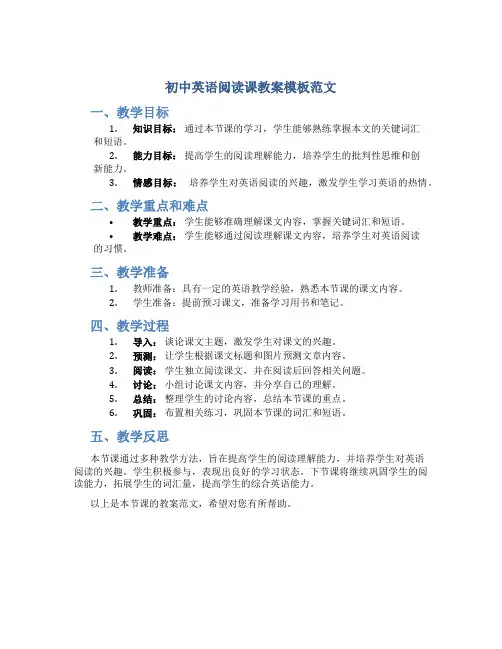
初中英语阅读课教案模板范文
一、教学目标
1.知识目标:通过本节课的学习,学生能够熟练掌握本文的关键词汇
和短语。
2.能力目标:提高学生的阅读理解能力,培养学生的批判性思维和创
新能力。
3.情感目标:培养学生对英语阅读的兴趣,激发学生学习英语的热情。
二、教学重点和难点
•教学重点:学生能够准确理解课文内容,掌握关键词汇和短语。
•教学难点:学生能够通过阅读理解课文内容,培养学生对英语阅读的习惯。
三、教学准备
1.教师准备:具有一定的英语教学经验,熟悉本节课的课文内容。
2.学生准备:提前预习课文,准备学习用书和笔记。
四、教学过程
1.导入:谈论课文主题,激发学生对课文的兴趣。
2.预测:让学生根据课文标题和图片预测文章内容。
3.阅读:学生独立阅读课文,并在阅读后回答相关问题。
4.讨论:小组讨论课文内容,并分享自己的理解。
5.总结:整理学生的讨论内容,总结本节课的重点。
6.巩固:布置相关练习,巩固本节课的词汇和短语。
五、教学反思
本节课通过多种教学方法,旨在提高学生的阅读理解能力,并培养学生对英语
阅读的兴趣。
学生积极参与,表现出良好的学习状态。
下节课将继续巩固学生的阅读能力,拓展学生的词汇量,提高学生的综合英语能力。
以上是本节课的教案范文,希望对您有所帮助。

初中英语阅读教案模板范文一、教学目标1.通过本节课的阅读活动,帮助学生掌握词汇及阅读技巧。
2.培养学生对于英语阅读的兴趣,提高阅读理解能力。
3.培养学生的思维能力,帮助他们更好地理解和运用所学内容。
二、教学重难点1. 教学重点•学生能够准确读出文章中的生词,理解文章大意。
•学生能够根据问题进行回答,培养学生的阅读理解能力。
2. 教学难点•学生对生词理解能力不足,需要通过课堂练习加强。
•学生阅读完文章后的问题回答,需要培养学生严密的逻辑思维能力。
三、教学准备1.教师准备教材:《初中英语阅读教材》,包含文章及相关问题。
2.学生准备:学生需要提前阅读教材,做好预习工作。
四、教学过程1. 导入(5分钟)教师简要介绍本节课的学习内容,并与学生一起回顾上节课内容,激发学生学习兴趣。
2. 阅读训练(30分钟)1.学生独立阅读文章,重点标记不理解的单词或句子。
2.学生阅读完毕后,教师提出相关问题,学生思考并作答。
3.教师根据学生的回答情况进行适时点评,引导学生加深对文章的理解。
3. 课堂讨论(15分钟)1.学生就文章内容进行小组讨论,交流各自的理解和看法。
2.教师引导学生展开讨论,鼓励学生积极参与。
4. 总结(5分钟)教师总结本节课的学习内容,强化重点,鼓励学生对所学知识进行总结和复习。
五、作业布置1.布置阅读作业:要求学生阅读一篇相关文章,完成相关问题的回答。
2.布置课外作业:要求学生每天坚持阅读英语文章,培养阅读习惯。
六、教学反思本节课教学目标明确,教师通过多种方式引导学生参与阅读活动,激发学生的学习兴趣,但在提问环节需要更多引导,培养学生主动思考能力,未来应加强此环节训练。
以上是初中英语阅读教案模板范文,希望对您有所帮助。

七年级英语阅读教案5篇2022阅读课是高中英语占比重的课型,对于高中生应该掌握的英语语言基础知识包括语音、词汇、语法和话题等五方面的内容,所以知识目标我们可以从这5方面进行思考。
能力目标的书写则应该从语言技能,即听说读写这四个方面的技能以及这四种技能的综合运用进行书写。
以下是小编带来的七年级英语阅读教案内容,感谢您的阅读,希望能帮助到您!七年级英语阅读教案1一、Teaching Demands and Aims(教学目标)二、Teaching important and difficult point (教学重点)1、words2、sentences3、grammars三、Teaching Aids (教具)四、Teaching procedures(教学过程) Greeting(问候) warm up(热身) Review(复习) New Leon(新课) Step One: Step Two: Step Three: Follow up(叮咛)五、Homework(作业布置)作业的布置一、书面作业1、每节课后教师可适当选择课后习题(书本或课外参考书)及字母作业。
2、低年纪的孩子适合听磁带读课文、画图、连线、写字母等简单作业;每学期两次测试:半期考和期末考试。
3、高年纪的孩子要求抄单词、背单词、背课文等书面作业;每节课前可做适当的听写练习;每个月可做适当的单元测试;期间两次大考:半期考和期末考。
二、磁带作业1、适时布置(条件允许可每周一次):将本周学习的内容录进磁带,下周上交。
2、录制要求:首先让学生和老师打招呼,接着报朗诵单元,然后录作业内容,最后与老师说再见。
(如:Hello! Amanda.I am Go go.This is Unit 11……… Goodbye! Amanda!)3、听音修正:(1)书面记录:边听边把学生的错音登记在学生手册上。
(2)修正过程:A:打招呼,先表扬肯定,后提出错误,注意错音的跟读B:说悄悄话,增进师生感情交流 C:提出问题。
初中阅读理解教案全英文版Grade Level: 7th GradeObjective:At the end of the lesson, students will be able to:1. Understand the main idea and key details of the given reading passage.2. Analyze the author's purpose and point of view.3. Identify and infer the meaning of unfamiliar vocabulary words.4. Summarize the information and retell the story in their own words.5. Participate in group discussions and express their opinions about the reading material. Materials:1. Reading passage2. Handout with vocabulary words and definitions3. Chart paper or whiteboard for group discussions4. Sticky notes for students to write their thoughtsProcedure:1. Introduction (10 minutes):a. Welcome students to the classroom and explain the objective of the lesson.b. Hand out the reading passage and ask students to read it silently for 5 minutes.c. After the reading time, ask students to share their initial reactions and thoughts about the passage.2. Vocabulary Building (10 minutes):a. Provide students with a handout containing vocabulary words and their definitions.b. Explain the meaning of each vocabulary word and ask students to underline the words as they encounter them in the passage.c. Encourage students to use context clues to infer the meaning of unfamiliar words.3. Guided Reading (15 minutes):a. Ask students to read the passage out loud with a partner, paying attention to the author's purpose and point of view.b. Circulate around the classroom, providing support and assistance to students as needed.c. Stop at key points in the passage and discuss the main idea and key details with the class.4. Group Discussions (10 minutes):a. Divide students into small groups and assign each group a specific question to discuss.b. Provide each group with a piece of chart paper or a whiteboard to record their thoughts and conclusions.c. Encourage students to actively participate in the discussions, ask questions, and share their opinions.5. Summarization and Retelling (5 minutes):a. Ask each group to report their findings and conclusions to the class.b. Encourage students to summarize the information and retell the story in their own words.c. Provide feedback and corrections as needed.6. Conclusion (5 minutes):a. Review the main idea and key details of the reading passage.b. Ask students to reflect on what they have learned and express their opinions about the reading material.c. Encourage students to continue practicing their reading comprehension skills outside of the classroom.Assessment:1.观察学生在阅读过程中的参与度和理解程度。
英语教案曲阳县北台中学2013年8月Lesson 9 Danny^s School Project北台中学教师张敏涛教学设计:本案例是reading (精读课),按照英语新课程标准的要求,这堂课应当是“以任务贯穿听、读、写的活动,让学生通过“感知概况——应用,的思维来增长知识,发展能力。
”基于此,其教育的落脚点有二:1学生通过阅读学习,有助于提高学生的阅读能力和自主学习能力。
2通过合作阅读进行语音处理、单词处理、短语处理和句子处理;通过阅读进行意义构建,在于文本相互构建的过程中,在理解、思辨的过程中培养学生的语言输出能力,即说话能力和写话能力。
教学目的:1try one,s best to do sth尽某人最大的努力做 ............2look like看起来像......3well done !干的好一般过去时指导重点:1 生词读音describe build ago army important toolmore 2句子语气和语调课前准备:1把所有学生分组,五人一组。
合理安排。
每组学生优差搭配。
2准备比赛小礼品。
指导课过程:Step 1 GreetingGood morning !/or Good afternoon! /How are you?Step 2 Leading—in课件出示一首Chant:Rabbit,sheep,lovely and meekDragon,snakejong and magicalOx , horse, strong and tallMouse,chicken,like eating riceTiger,dog,pig and monkeyThey5re very pretty!Step 3 Reading1 Listen to the tape o (students look at their books and find they doiftread the words or the new words.)2教师教授新单词,讲解课文,而后领读课文。
LESSON PLAN英语拓展阅读教案Time of Lesson: 45 minutes课时:45分钟Students: Grade seven授课对象:七年级学生Lecture:讲课人:张玉环Lesson Type: Reading课程类型:阅读Teaching Material: English reading methods讲课内容:英语阅读方法Teaching Objectives:教学目标:1,Ss learn some reading methods ,let them get some reading abilities学生学习一些阅读方法,使其获得一定的阅读能力2,Ss can improve the reading comprehension to some degree.( To get message from what they read.)在某种程度上,学生能够提高阅读理解能力。
(从阅读的文章中获得信息)Important Point:教学重点:1,Ss can learn and master the following language points:学生能够学习和掌握以下语言知识:New Wordsphrasesthe structureDifficult Points:教学难点:1,How to use the language points learned in the text如何使用文章中学到的语言知识2,Ss can improve the reading comprehension to some degree.在某种程度上,学生能够提高阅读理解能力。
Properties:教具:Radio; pictures; chalk; blackboard;影像;图片;粉笔;黑板;Teaching Method:教学方法:1,Communicative Approach;交际教学法;2,Reading Comprehension;阅读理解;3,Note Making;做笔记;4,Discussion.讨论Teaching Procedures:教学步骤:一、导入二、走进英语谚语激发兴趣,培养语感,提高阅读理解能力三、英语故事欣赏,了解中西方文化差异四、阅读与思考突破方法:阅读能力培养1. 培养良好的阅读习惯良好的阅读习惯会提高英语阅读速度,对英语学习者产生持久深远的影响。
初一英语阅读课教案(经典版)编制人:__________________审核人:__________________审批人:__________________编制单位:__________________编制时间:____年____月____日序言下载提示:该文档是本店铺精心编制而成的,希望大家下载后,能够帮助大家解决实际问题。
文档下载后可定制修改,请根据实际需要进行调整和使用,谢谢!并且,本店铺为大家提供各种类型的经典范文,如工作总结、述职报告、策划方案、演讲致辞、合同协议、条据文书、教案资料、好词好句、作文大全、其他范文等等,想了解不同范文格式和写法,敬请关注!Download tips: This document is carefully compiled by this editor. I hope that after you download it, it can help you solve practical problems. The document can be customized and modified after downloading, please adjust and use it according to actual needs, thank you!Moreover, our store provides various types of classic sample essays for everyone, such as work summaries, job reports, planning plans, speeches, contract agreements, doctrinal documents, lesson plans, good words and sentences, complete essays, and other sample essays. If you want to learn about different sample formats and writing methods, please pay attention!初一英语阅读课教案英语老师要让学生激发学习英语的兴趣,培养学习英语的良好习惯,树立学习英语的自信。